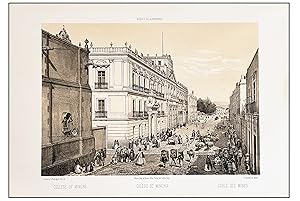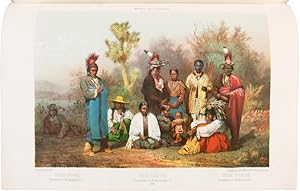casimiro castro rodriguez (4 resultados)
Tipo de artículo
- Todo tipo de artículos
- Libros (4)
- Revistas y publicaciones
- Cómics
- Partituras
- Arte, grabados y pósters
- Fotografías
- Mapas
-
Manuscritos y
coleccionismo de papel
Condición
- Todo
- Nuevos
- Antiguos o usados
Encuadernación
- Todo
- Tapa dura (2)
- Tapa blanda
Más atributos
- Primera edición
- Firmado
- Sobrecubierta
- Con imágenes del vendedor (2)
- Sin impresión bajo demanda
Ubicación del vendedor
Valoración de los vendedores
-
COLEGIO DE MINERIA (CIUDAD DE MÉXICO)
Publicado por Decaen, Mexico, 1863
Librería: LIBRERIA ANTICUARIA MARGARITA DE DIOS, MADRID, España
Miembro de asociación: LANCE
Condición: Muy bien. Materia: Litografía siglo XIX. México. Publicación: México, Ejecutado en el establecimiento Litográfico de Decaen, 1863. Técnica: Litografía. Medidas: 30 x 43 cm Casimiro Castro (1826, Tepetlaoxtoc a 1889, Ciudad de México) fue un dibujante, litógrafo y pintor mexicano. Es considerado cronista gráfico y paisajista de gran fama en el México del siglo XIX. A mediados del siglo XIX publicó la obra México y sus alrededores" siendo el principal autor Casimiro Castro, participan además los artistas Julián Campillo, Luis Auda y G. Rodríguez. Esta obra incluía 42 estampas relativas a la Ciudad de México y su entorno de las cuales 31 eran obra de Casimiro Castro: se incluían vistas aéreas captadas desde globos aerostáticos o desde azoteas. "México y sus alrededores" es considerada una joya de la litografía mexicana del Siglo XIX debido a la calidad de sus dibujos y sus litografías. Conservación: Muy buena. BS1".
-
MÉXICO Y SUS ALREDEDORES. Colección de vistas monumentales, paisajes y trajes del país. Dibujados al natural y litografiados por los artistas mexicanos C. Castro, G. Rodríguez é I. Campillo bajo la dirección de V. Debray. Los artículos descriptivos son de los señores D. Marcos Arronis, D. José T. de Cuellar, D. Florencio M. del Castillo ( )
Publicado por México. Imprenta litográfica de V. Debray, editor. Esquina del Portal del Coliseo Viejo y Callejón del Espíritu Santo. 1869., 1869
Librería: Boza & O'shee - Rare Books, Sevilla, España
Libro
Encuadernación de tapa dura. Condición: Aceptable. Sin Sobrecubierta. Folio (46 x 32 cm). [80] pp. (texto), 1 mapa desplegable de la Ciudad de México en 1869 (67,5 x 84 cm), 47 láminas cromolitográficas y litográficas, 1 carta general de la República Mexicana en 1870 (54,5 x 75 cm). Hoja manuscrita con índice de láminas. El ejemplar, está falto de la cromolitografía que representa la casa del Emperador Iturbide. En todo caso, ejemplar más completo del mercado actualmente (2023). Obra encuadernada en tela editorial, tela deteriorada y con manchas de humedad, guardas en mal estado. Manchas de humedad y ataque de hongos en el mapa del final, que ha sido reforzado por detrás con papel japonés libre de ácido, para evitar pérdidas. Algunas láminas con manchas de óxido y humedad, ver fotografías.
-
Mexico y sus Alrededores
Publicado por Mexico: Imprenta Litografica de V. Debray, 1869, 1869
Librería: Arader Galleries - AraderNYC, New York, NY, Estados Unidos de America
CASTRO, Casimiro, Juan Campillo, L. Auda, G. Rodriguez, et al. Mexico y sus alrededores. Coleccion de vistas monumentales, paisajes y trajes des pais. Dibujados al natural y litografiados por los artistas mexicanos.bajo la direccion de V. Debray. Los articulos descriptivos son de los Senores D. Marcos Arroniz [and others].Nueva edicion aumentada. Mexico: Imprenta Litografica de V. Debray, Editor, Esquina del Portal de Coliseo Viejo y Callejon del Espiritu Santo, 1869. Folio (17 4/8 x 12 2/8 inches). Half-title (torn), title-page and text in Spanish and French. Additional chromolithographed undated title-page, 44 (of 47) chromolithographed plates with captions in English, Spanish, and French (some edges frayed, without maps). Original publisher's original brown pebble cloth, gilt-lettered on upper cover: Mexico y sus alrededores 1870 (all plates loose). Offered as a collection of plates. Originally issued by subscription from 1855. Depicting scenes throughout the Mexico City. Palau 167505.
-
MÉXICO Y SUS ALREDEDORES. COLECCION DE MONUMENTOS, TRAJES Y PAISAJES.SEGUNDA EDICION, AUMENTADA. / MEXICO ET SES ENVIRONS. COLLECTION DE VUES, MONUMENTS ET COSTUMES.SECONDE ÉDITION, AUGMENTÉE.
Publicado por Imprenta Lithografica de Decaen, Mexico, 1864
Librería: William Reese Company - Americana, New Haven, CT, Estados Unidos de America
[2],70,v pp. of letterpress text in two columns in Spanish and French, plus tinted lithographic title, forty-nine lithographic views on forty-five leaves (forty-one color lithographed, three tinted, one uncolored), all with tissue guards, folding lithographed map of Mexico City (dated 1875), and a later folding map of Mexico (dated 1872) bound at rear. Half title. Large folio. Antique-style three- quarter maroon calf and contemporary marbled paper-covered boards, original gilt spine label, new endpapers. Minor edge wear, a few small chips to paper boards. Repaired tear in half title leaf. Half title, title leaf, and first leaf of text repaired in gutter, marginal repair at binding stub of folding map. Even tanning to text leaves, mild to moderate foxing to plates. Very good. A highly significant Mexican lithographic production and a wonderful window on 19th- century life in Mexico City. This example includes the rare map of Mexico City (dated 1875) and the Kickapoo Indians plate. There are many issues of this work, with varying numbers and qualities of plates. The work was originally issued by subscription starting in 1855, and the first bound copies became available in 1856. It is almost certain that from the beginning the book was published as demanded by the marketplace, consequently there are no formal "editions" in the proper sense. Over the years individual plates were completely modified in accordance with physical changes to a site (as an example, at one point the plate depicting the home of Emperor Iturbide changes completely to a different perspective). Copies are reported to have anywhere from twenty-eight to fifty-two plates, and a very few examples contain a map of Mexico (including the present copy, which has two maps of Mexico, though both are dated later than usually seen). The dates found on different copies add to the confusion, especially since up to three different dates can be found in some copies. In a recent study of Castro's work, CASIMIRO CASTRO Y SU TALLER (1996), a census of copies of MEXICO Y SUS ALREDEDORES is given, listing the various recorded combinations of dates. The present example is dated 1864 on the letterpress titlepage (where it is stated as the second edition), undated on the lithographic titlepage (which sometimes carries its own imprint date), and has maps dated 1872 and 1875. The plates are of the highest quality and depict scenes throughout the Mexican capital, including the National Palace, the cathedral of Guadalupe, Iturbide's mansion, Mexican señoritas, the College of Mines, Paseo de Bucareli, the Alameda of Mexico (with an air balloon towering above), Paseo de la Viga, and the sumptuous interior of the national cathedral, and public squares and gardens, among many other beautiful scenes. Of great importance in the present example is the color plate titled "Indios Kikapoos," a rarely-found image depicting eleven Kickapoo tribesmen, including a runaway Texas slave, being presented at the court of the Austrian Archduke and Emperor of Mexico, Maximilian, in 1865. The Kickapoo sought to avoid involvement with the Confederacy or Union in the Civil War and pleaded for asylum from Texans who were on the war path against them. The origin of the name Kickapoo ("he moves about") certainly fits the history of this interesting people, who more than most any other North American tribe have retained their cultural identity and practices despite geographic fluctuations and myriad alliances. The Kickapoo tribe is the only tribe that never surrendered to or signed any kind of peace treaty with the United States. They were granted the right to cross the border at will. The present lithograph of the Kickapoos has been suggested as the first lithograph made from a photograph in Mexico at the time. Close examination reveals the image to be a lithographic combination of realism and artistic imagination and the image was likely partially based on a photograph by François Aubert (1839-1900). Mathes describes this book as "the most important work illustrating Mexico City in the nineteenth century," and it is certainly a landmark in the history of the lithographer's art in Mexico. McGrath adds: "These are some of the finest and most famous architectural and costume plates done in the western hemisphere." The present copy contains two folding maps of Mexico. The first is dated 1875, and titled PLANO GENERAL DE LA CIUDAD DE MÉXICO. The second is titled CARTA GENERAL DE LA REPUBLICA MEXICANA, and dated 1872. Like the majority of the plates in the work, both of these maps were lithographed by Debray. On the titlepage, the publishers refer to this edition as the second, augmented edition, and it certainly displays hallmarks of later editions of the work. Almost all the lithographic attributions are altered from "Decaen" to "Decaen y Debray" or simply "Debray." More elements of updated transportation are included, reflecting the beginning of modernization of the transportation system in Mexico (one of the plates shows the train station at Puebla, and some plates incorporate streetcars and railroad lines). This album adds fifteen images new to the later editions, some of which use prior subjects but rework the plates significantly or in total. Some of the new or reworked lithographs are due to changes in architecture and public spaces ordered by Emperor Maximilian during French occupation (1864-1867). The heavy splendor of French Second Empire architecture was imported into Mexico, and the famous gardens and castle at Chapultepec and other architecture and public properties were beautified by the Emperor. His choices resulted in many beautiful structures and parks. Maximilian was executed, but the Second Empire architectural style he introduced to Mexico remained a significant influence on Mexican style and lives on in Mexico today. A wonderful example of a landmark work of Mexican lithography, with more plates than are usually encountered, and some showing the evolution.




